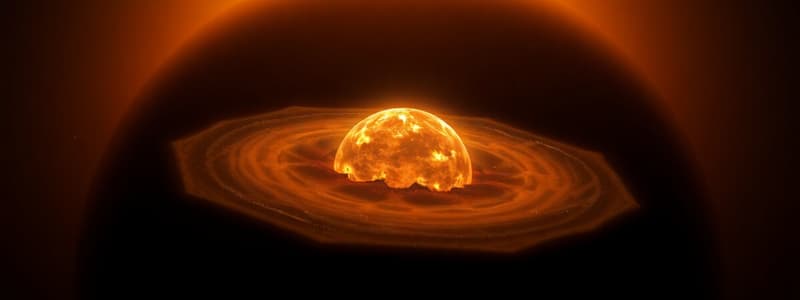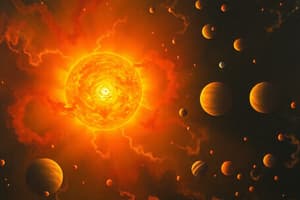Podcast
Questions and Answers
Who first proposed the idea that the universe was formed by clouds of gas?
Who first proposed the idea that the universe was formed by clouds of gas?
- Emanuel Swedenborg (correct)
- Isaac Newton
- Pierre-Simon Laplace
- Immanuel Kant
Which scientist further developed the Nebular Theory in 1755?
Which scientist further developed the Nebular Theory in 1755?
- Pierre-Simon Laplace
- Emanuel Swedenborg
- Immanuel Kant (correct)
- Isaac Newton
What did Pierre-Simon Laplace suggest about the formation of the Solar System in 1796?
What did Pierre-Simon Laplace suggest about the formation of the Solar System in 1796?
- It was formed from static clouds of gas.
- It formed from a rotating nebula that cooled and collapsed. (correct)
- It was a result of a catastrophic explosion.
- It consisted only of the Sun with no planets.
In which publication did Immanuel Kant outline his theories regarding the formation of the Solar System?
In which publication did Immanuel Kant outline his theories regarding the formation of the Solar System?
What modification did Pierre-Simon Laplace make to Kant’s ideas in 1796?
What modification did Pierre-Simon Laplace make to Kant’s ideas in 1796?
What did Emanuel Swedenborg contribute to the Nebular Theory?
What did Emanuel Swedenborg contribute to the Nebular Theory?
How did Immanuel Kant's work relate to the development of the Nebular Theory?
How did Immanuel Kant's work relate to the development of the Nebular Theory?
What modification did Pierre-Simon Laplace make to the Nebular Theory in 1796?
What modification did Pierre-Simon Laplace make to the Nebular Theory in 1796?
Which of the following best describes the process Kant suggested for planetary formation?
Which of the following best describes the process Kant suggested for planetary formation?
What central idea unifies the contributions of Swedenborg, Kant, and Laplace in the context of the Nebular Theory?
What central idea unifies the contributions of Swedenborg, Kant, and Laplace in the context of the Nebular Theory?
Flashcards
Emanuel Swedenborg (1734)
Emanuel Swedenborg (1734)
Proposed the nebular theory, suggesting the universe formed from gas clouds.
Immanuel Kant (1755)
Immanuel Kant (1755)
Developed Swedenborg's nebular theory, proposing solar system formation from orbiting gas and dust.
Pierre Laplace (1796)
Pierre Laplace (1796)
Modified Kant's nebular theory, suggesting a rotating nebula condensing into rings, forming planets and the Sun.
Nebular Theory
Nebular Theory
Signup and view all the flashcards
Solar System Formation
Solar System Formation
Signup and view all the flashcards
Swedenborg's Idea (1734)
Swedenborg's Idea (1734)
Signup and view all the flashcards
Kant's Refinement (1755)
Kant's Refinement (1755)
Signup and view all the flashcards
Laplace's Modification (1796)
Laplace's Modification (1796)
Signup and view all the flashcards
Nebular Theory (basic)
Nebular Theory (basic)
Signup and view all the flashcards
Solar System Origin
Solar System Origin
Signup and view all the flashcards
Study Notes
Formation of the Solar System
- The solar system formed from a cloud of gas and dust called a planetary nebula.
- This nebula condensed due to its own gravity.
- Possible causes for the nebula's collapse include: leftover gas and dust from a Red Giant, or a supernova from a white dwarf or nearby star.
- The cloud's compression and angular momentum caused it to spin faster, resulting in a flattened disc shape.
- The middle of the disc heated up significantly and fusion began, forming the protostar, the early sun.
- Chunks within the disc collided and stuck together, forming larger and larger chunks, a process called accretion.
- These chunks, called planetesimals, are the building blocks of planets.
- Planetesimals continued to grow by capturing material from the nebula as it cooled.
- The type of planet that formed depended on the temperature of its location relative to the sun.
Important People
- Emanuel Swedenborg proposed the nebular hypothesis in 1734, suggesting that the universe was formed from clouds of gas.
- Immanuel Kant further developed the theory in 1755, suggesting the solar system formed from gas and dust orbiting the sun.
- Pierre Laplace modified Kant's theory in 1796, suggesting the Sun and planets formed in a rotating nebula that cooled and collapsed, creating rings that became planets.
Inner vs. Outer Planets
- The temperature of different regions in the early solar system determined the type of planets that formed there.
- Closer to the sun, the temperature was too high for hydrogen compounds, so only rocks and metals condensed. The inner planets (Mercury, Venus, Earth, and Mars) are predominantly rocky with metal cores.
- Further from the sun, hydrogen compounds condensed along with rocks and metals, creating the outer gas-giant planets (Jupiter, Saturn, Uranus, and Neptune).
Studying That Suits You
Use AI to generate personalized quizzes and flashcards to suit your learning preferences.




